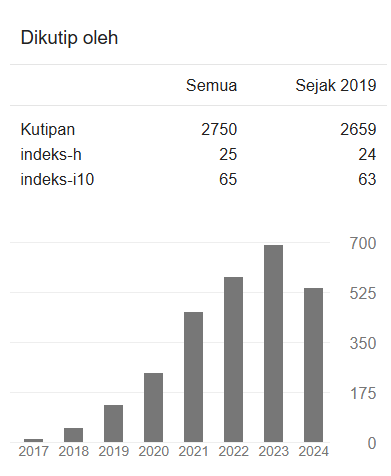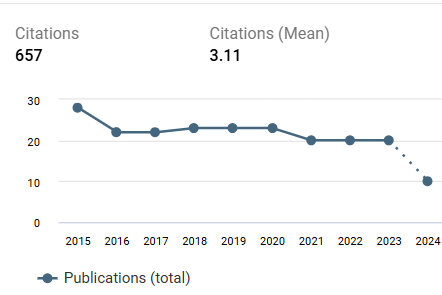The development of electronic worksheets for students using Live worksheets and GeoGebra to enhance students’ digital literacy
DOI:
https://doi.org/10.22219/jinop.v10i2.33688Keywords:
Digital Literacy, Electronic Worksheet, GeoGebra, Liveworksheets, Research and DevelopmentAbstract
Educational digitalization is characterized by technology-assisted media, leading to improved students’ digital literacy. One of these media is the electronic worksheet for students. An initial observation revealed that learning activities at Public Islamic Senior High School (MAN) in Bondowoso still operationalized conventional books as the sole media. This study aimed to develop electronic worksheets for students using valid, effective, and practical Geogebra-assisted live worksheets, guided by the 4-D model designed by Thiagarajan. This model consisted of four stages, i.e., define, design, develop, and disseminate. Data were collected through observation, tests, and questionnaires. Test questions were used to determine the level of effectiveness, and questionnaires were used for validity and practicality tests. The results revealed very high validity. The effectiveness analysis exhibited an N-Gain percentage of 76%, signifying a satisfactory effectiveness rate. The practicality analysis marked 86.20%, which is classified into a good category. The analysis results corroborated that electronic worksheets for students have proven valid, effective, and practical, demonstrating the potential to improve students' digital literacy.
Downloads
References
Amalia, I., Roesminingsih, M. V., & Yani, M. T. (2022). Pengembangan LKPD Interaktif Berbasis Liveworksheet untuk Meningkatkan Hasil Belajar IPS Sekolah Dasar. Jurnal Basicedu, 6(5), 8153–8162. https://jbasic.org/index.php/basicedu/article/view/3762
Ayuni, R., Romadon, & Kusuma, A. I. (2022). Pengembangan video animasi pembelajaran matematika berbasis nilai-nilai kewirausahaan di sekolah dasar. JINoP (Jurnal Inovasi Pembelajaran), 8(2), 139–155. https://doi.org/10.22219/jinop.v8i2.19462
Belanisa, F., Amir, F. R., & Sudjani, D. H. (2022). E-modul Interaktif Sebagai Media Pembelajaran Bahasa Arab Untuk Meningkatkan Motivasi Siswa. Tatsqifiy: Jurnal Pendidikan Bahasa Arab, 3(1), 1–12. https://doi.org/10.30997/tjpba.v3i1.4754
Cirneanu, A., & Moldoveanu, C.-E. (2024). Use of Digital Technology in Integrated Mathematics Education. Applied System Innovation, 7(66). https://doi.org/https://doi.org/10.3390/asi7040066
Doc, N. Van, Giam, N. M., Nam, N. T. H., Thanh, N. T., & Giang, N. T. H. (2023). Applying Algorithmic Thinking to Teaching Graphs of Functions For Students Through GeoGebra. Journal of Education For Sustainable Innovation, 1(2), 85–94. https://doi.org/10.56916/jesi.v1i2.554
Elfandi, P., Ramadhani, D. D., Siti, W., Kharisma, G., Alda, D., & Delima, N. (2023). Meningkatkan Kemampuan Berpikir Kritis dan Kreatif Matematis serta Literasi Digital Siswa melalui Model Berbantuan Blended-Comprehensive Mathematics Instruction Berbantuan GeoGebra. Jurnal Imiah Fakultas Keguruan Dan Imu Pendidikan, 9(1), 37–44. https://doi.org/https://doi.org/10.35569/biormatika.v9i1.1432
Fatahillah, A., Puspitasari, I. D., & Hussen, S. (2020). The development of Schoology web-based learning media with GeoGebra to improve the ICT literacy on quadratic functions. JRAMathEdu (Journal of Research and Advances in Mathematics Education), 5(3), 304–316. https://doi.org/10.23917/jramathedu.v5i3.10692
Handayani, T., Rahmandani, F., & Muzzaki, A. (2023). Inovasi Pembelajaran Berbasis Digital Melalui Liveworksheet untuk Membudayakan Keterampilan Digital Peserta Didik. JINoP (Jurnal Inovasi Pembelajaran), 9(1), 31–43. https://doi.org/10.22219/jinop.v1i1.2441
Hudu, A., Kwakye, D. O., Bornaa, C. S., Churcher, K. A., & Atepor, S. (2024). Students’ Performance and ICT Capabilities in Quadratic Functions Using GeoGebra. European Journal of Theoretical and Applied Sciences, 2(1), 219–231. https://doi.org/10.59324/ejtas.2024.2(1).16
Hussen, S., Setiawani, S., Fatahillah, A., Monalisa, L. A., Albirri, E. R., & Mutrofin, S. (2021). Developing online interactive learning media by using easyclass with GeoGebra to help students representation mathematic on linear programming. Journal of Physics: Conference Series, 1832(1). https://doi.org/10.1088/1742-6596/1832/1/012032
Kartikaningsih, R., Nurlansi, & Zaeni, A. (2021). Pengembangan Perangkat Pembelajaran Yang Menerapkan Model Problem Based Learning Untuk Meningkatkan Pemahaman Konsep Dan Keterampilan Proses Sains Siswa Pada Materi Larutan Penyangga. Jurnal Biofiskim: Penelitian Dan Pembelajaran IPA, 3(1), 65–74. https://doi.org/http://dx.doi.org/10.33772/biofiskim.v3i1.17176
Khasanah, U., & Nugraheni, E. A. (2022). Analisis Minat Belajar Matematika Siswa Kelas VII Pada Materi Segiempat Berbantuan Aplikasi GeoGebra di SMP Negeri 239 Jakarta. Jurnal Cendekia: Jurnal Pendidikan Matematika, 06(01), 181–190. https://doi.org/10.31004/cendekia.v6i1.813
Koskenoja, M., & Törmä, T. (2023). Editorial: Special Issue “Technology in Mathematics Education.” Lumat, 11(3). https://doi.org/10.31129/LUMAT.11.3.2141
Lathifah, M. F., Hidayati, B. N., & Zulandari. (2021). Efektifitas LKPD Elektronik sebagai Media Pembelajaran pada Masa Pandemi Covid-19 untuk Guru di YPI Bidayatul Hidayah Ampenan. Jurnal Pengabdian Magister Pendidikan IPA Original, 4(2), 25–30. https://doi.org/10.29303/jpmpi.v4i2.668
Mufida, L., Subandowo, M., & Gunawan, W. (2022). Pengembangan E-Modul Kimia Pada Materi Struktur Atom Untuk Meningkatkan Hasil Belajar. JIPI (Jurnal Ilmiah Penelitian Dan Pembelajaran Informatika), 7(1), 138–146. https://doi.org/10.29100/jipi.v7i1.2498
Nabilla, N., Edy, S., & Khikmiyah, F. (2022). Pengembangan E-LKPD Matematika Interaktif Berbasis Literasi Digital. Jurnal Pembelajaran Matematika Inovatif, 5(6), 1581–1594. https://doi.org/10.22460/jpmi.v5i6.1581-1594
Nengsih, Setiadi, A. E., & Sunandar, A. (2023). Development of augmented reality learning media based on assemblr studio web in ecosystem material. JINoP (Jurnal Inovasi Pembelajaran), 9(2), 277–291. https://doi.org/10.22219/jinop.v9i2.25251
Nirmayani, L. H. (2022). Kegunaan Aplikasi Liveworksheet Sebagai LKPD Interaktif Bagi Guru-Guru SD di Masa Pembelajaran Daring Pandemi Covid 19. Edukasi: Jurnal Pendidikan Dasar, 3(1), 9–16. https://doi.org/10.55115/edukasi.v3i1.2295
Pramono, K. H. (2022). Pengembangan Media Video Pembelajaran Untuk Meningkatkan Motivasi Belajar Pada Matakuliah Metode Penelitian Teater Menggunakan Model R&D. TONIL: Jurnal Kajian Sastra, Teater Dan Sinema, 19(1), 9–16. https://doi.org/10.24821/tnl.v19i1.6949
Rohman, P. N., Na’im, M., & Sumardi. (2021). Pengembangan media berbasis prezi pada mata pelajaran sejarah kelas X SMA dengan model 4d. JINoP (Jurnal Inovasi Pembelajaran), 7(1), 1–9. https://doi.org/10.22219/jinop.v7i1.13054
Sari, D. S., Widiyawati, Y., Nurwahidah, I., Masykuri, M., & Budiyanto, C. W. (2021). The Development of E-Worksheet Based on Project to Promote Student’s Creative Thinking and Digital Literacy Skills. Proceedings of the 7th International Conference on Research, Implementation, and Education of Mathematics and Sciences (ICRIEMS 2020), 528(Icriems 2020), 647–654. https://doi.org/10.2991/assehr.k.210305.094
Sari, L., Taufina, & Farida. (2020). Pengembangan Lembar Kerja Peserta Didik (LKPD) Dengan Menggunakan Model PJBL Di Sekolah Dasar. Jurnal Basicedu, 4(4), 813–820. https://doi.org/10.31004/basicedu.v4i4.434
Septia, Tika. & Wahyu, Rahma. (2023). Literasi Digital Peserta Didik Dalam Pembelajaran Geometri Terintegrasi Geogebra. Plusminus: Jurnal Pendidikan Matematika. 3(1). https://doi.org/10.31980/plusminus.v3i1.1222
Simamora, A. A., Asri, M. T. (2024). Pengembangan E-LKPD Interaktif untuk Melatihkan Kemampuan Literasi Digital Peserta Didik Kelas X SMA pada Materi Virus. Jurnal BioEdu. 13(2). 339-355. https://doi.org/10.26740/bioedu.v13n2.p339-355
Subandi, I. P., Sudzuasmais, Triana, A. D., & Hidayah, R. (2023). Pengembangan E-LKPD Berbasis Problem Based Learning Untuk Meningkatkan Hasil Belajar Peserta Didik Pada Materi Minyak Bumi Di Era Merdeka Belajar. Journal of Chemical Education, 17(1), 59–66. https://doi.org/10.26740/ujced.v12n1.p59-66
Susanti, V. D., & Damayanti, A. (2022). Pengembangan Video Pembelajaran Animasi Berbasis Animaker Materi Garis Dan Sudut Untuk Meningkatkan Minat Belajar Siswa Smpn 1 Geger Di Masa Pandemi Covid-19. Prima Magistra: Jurnal Ilmiah Kependidikan, 3(3), 331–341. https://doi.org/10.37478/jpm.v3i3.2024
Syarifah, I. L., Hidayah, F. N., Raharani, F. A.-N., Azzahra, N. I., Mukarromah, S., Yulianti, Y., & Wulandari. (2021). Pentingnya Literasi Digital di Era Pandemi. Jurnal Implementasi, 1 (2)(2), 162–168. http://jurnalilmiah.org/journal/index.php/ji/article/view/60
Wahyuni, Y., Fauzan, A., Yerizon, Y., & Musdi, E. (2022). Analisis Literasi Digital Mahasiswa dalam Pembelajaran Matematika Berbasis Geogebra. Jurnal Cendekia: Jurnal Pendidikan Matematika, 6(3), 3358–3371. https://doi.org/10.31004/cendekia.v6i3.1737
Wahyuningtyas, N., & Yahya, M. H. (2021). Pengembangan aplikasi “SIMBA” (Social studies instructional media based android) untuk mata pelajaran IPS kelas VII SMP. JINoP (Jurnal Inovasi Pembelajaran), 7(2), 153–166. https://doi.org/10.22219/jinop.v7i2.15918
Wicaksono, Y. A., & Kuswanti, N. (2022). Pengembangan Flipbook pada Materi Sistem Ekskresi Manusia untuk Melatih Keterampilan Literasi Digital Siswa Kelas XI SMA. Berkala Ilmiah Pendidikan Biologi (BioEdu), 11(2), 502–514. https://doi.org/10.31004/cendekia.v6i3.1737
Yuliyanti, D. D., Kristiana, A. I., & Monalisa, L. A. (2021). Pengembangan Media Pembelajaran Berbasis TI pada Materi Penyajian Data Kelas VII untuk Meningkatkan Hasil Belajar. Cgant Journal of Mathematics and Applications, 2(2). https://doi.org/10.25037/cgantjma.v2i2.60
Downloads
Published
How to Cite
Issue
Section
License
Copyright (c) 2024 Monalisa et al

This work is licensed under a Creative Commons Attribution 4.0 International License.
Copyright Notice
Authors who publish with JINoP (Jurnal Inoasi Pembelajaran) agree to the following terms:
- For all articles published in the JINoP (Jurnal Inovasi Pembelajaran), copyright is retained by the authors. Authors give permission to the publisher to announce the work with conditions. When the manuscript is accepted for publication, the authors agree to the automatic transfer of the publishing right to the publisher.
- Authors retain copyright and grant the journal the right of first publication with the work simultaneously licensed under a Creative Commons Attribution 4.0 International License. that allows others to share the work with an acknowledgment of the work's authorship and initial publication in this journal.
- Authors are able to enter into separate, additional contractual arrangements for the non-exclusive distribution of the journal's published version of the work (e.g., post it to an institutional repository or publish it in a book), with an acknowledgment of its initial publication in this journal.
- Authors are permitted and encouraged to post their work online (e.g., in institutional repositories or on their website) prior to and during the submission process, as it can lead to productive exchanges, as well as earlier and greater citation of published work (See The Effect of Open Access).








